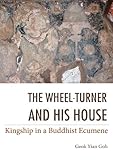The Wheel-Turner and His House : Kingship in a Buddhist Ecumene / Geok Goh.
Material type: TextPublisher: Ithaca, NY : Cornell University Press, [2021]Copyright date: ©2015Description: 1 online resource (250 p.) : 4 illustrations, 6 mapsContent type:
TextPublisher: Ithaca, NY : Cornell University Press, [2021]Copyright date: ©2015Description: 1 online resource (250 p.) : 4 illustrations, 6 mapsContent type: - 9781501757990
- 959.1/02 23
- DS529.2 .G64 2015eb
- online - DeGruyter
| Item type | Current library | Call number | URL | Status | Notes | Barcode | |
|---|---|---|---|---|---|---|---|
 eBook
eBook
|
Biblioteca "Angelicum" Pont. Univ. S.Tommaso d'Aquino Nuvola online | online - DeGruyter (Browse shelf(Opens below)) | Online access | Not for loan (Accesso limitato) | Accesso per gli utenti autorizzati / Access for authorized users | (dgr)9781501757990 |
Frontmatter -- Contents -- Lists of Figures & Maps -- List of Abbreviations -- Note on Transliteration -- Preface -- Introduction -- PART ONE-The Historical Context -- 1-The Genesis of the King -- 2-The King and His Ecumene -- PART TWO-The King in the Story: Orality and Literacy in Myanmar and Southeast Asia -- 3-The Yazawin: Orality and Literacy -- 4-U Kala and the Anawrahta Story -- 5-Makers of Burmese History after U Kala -- PART THREE-Reinventing the King -- 6-The King as Hero: Memory and History in Modern Burma 175 Postscript-The Narrative Comes Full Cycle -- Notes -- Bibliography -- Index
restricted access online access with authorization star
http://purl.org/coar/access_right/c_16ec
The recorded history of precolonial Burmese empire and the modern state of Myanmar starts with the kingdom of Bagan in the eleventh century. The oldest surviving written records and structures are from the reign of King Anawrahta (1044–1077). Anawrahta converted to Theravada Buddhism and created a vibrant Buddhist state in the Irrawaddy River basin. Anawrahta is a folk hero to this day in Myanmar and is widely credited as a charismatic and pious leader who consolidated various ethnic groups throughout the region into a single nation. The Wheel-Turner and His House traces the archaeological and historical record of Anawrahta and his seminal position in forming modern Myanmar, based on the few sources that have been recovered. The Great Chronicle, an important history of the country written by the 18th-century Burmese nobleman U Kala, forms the basis for much of the knowledge we have about Anawrahta today. Geok Yian Goh examines U Kala's work in light of the context of U Kala's own time and points out the bias of his royal court, as well as the scribe's personal views from the elaborate narratives he produced. She looks at other sources as well, including unpublished palm-leaf manuscripts, to disentangle earlier knowledge about Anawrahta and eleventh-century Bagan. Placing the overall study of Burmese historical tradition within the larger manuscript culture of Asia, Goh presents a critique of theoretical issues in history, especially the relationship between the past and memory. In order to analyze the expansion of Anawrahta's historical image that formed the development of a Buddhist ecumene in the eleventh and twelth centuries, Goh utilizes published and unpublished texts in Burmese and classical Chinese, along with northern Thai and Sri Lankan texts, many of which Goh makes available for the first time in English.
Mode of access: Internet via World Wide Web.
In English.
Description based on online resource; title from PDF title page (publisher's Web site, viewed 02. Mrz 2022)


